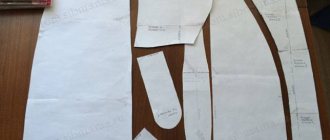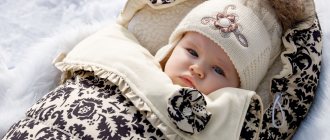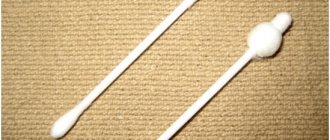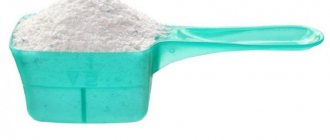Even before the baby is born, the mother thinks through absolutely all the details concerning the newborn. Especially clothes, children's textiles. In addition to vests and caps, close attention should be paid to the blanket. It contains a child on his way home from the maternity hospital during the first months of his life. The choice will depend on weather conditions and the time of year the little one was born. It is better to give preference to a natural product. It is not cold, not hot, the body breathes. It is not blown through, dense, soft, approximately 1.20 x 1.20 in size. Let's figure out how to wrap a baby in a blanket or diaper.
Walk
We need a diaper and a blanket. The first one replaces clothes. The fabric is cotton, soft, pleasant. The second will warm the child and limit movements.
Diaper
- Cover the baby with the right corner of the diaper. The left leg remains free.
We wrap the right end over the shoulder - under the back
- We cover the body with the lower part. We refuel.
We also wrap it over the left shoulder and under the back - We wrap the other end around the baby. We tuck it under the back.
Straighten the bottom edge of the diaper and wrap it over the baby’s tummy
We fasten the free ends of the diaper into a fold
Blanket
- We place the child closer to the edge.
- We cover the toddler with the lower part up to the chin. The remaining corner is folded inward.
- Cover the child with the left one. Tucked under the back.
- We cover the other, wrap it, straighten the folds.
- We fix it in a convenient way: fastener, tape, without fixation.
You can't swaddle tightly. The child should feel comfortable. Instead of a diaper, it is allowed to use a specialized cocoon with Velcro and zippers.
How to tie
Many craftswomen advise using the actual crochet hook: it is easier to knit with it than with knitting needles. The production time is longer than when using knitting needles, but lace envelopes are so impressive that it is worth the effort to create an original product.
Advantages of the hook:
- a beginning needlewoman first knits small squares, then knits the motifs into a single piece;
- the patterns are simple, accessible even to inexperienced knitters;
- it is easy to produce both fantasy motifs and strict geometric figures;
- often there are no complex patterns, as when knitting some patterns on knitting needles;
- the craftswoman can combine motifs at her own discretion, adding more circles or squares.
How to knit a transforming envelope:
- choose a model, diagram, count the number of squares or circles for the finished product;
- create an elegant canvas from squares knitted together;
- the optimal length of the hanging fabric is 74–80 cm. The finished rectangle should be exactly this size;
- Also connect another rectangle from small motifs. Size 24–30 cm (1/3 of the finished product and the width of the envelope);
- accessories will help create the correct shape: buttons, zippers or a combination of these devices;
- Divide the top edge of the envelope in half, from the center point, but not to the very edge, sew in a zipper. When buttoned, it creates a calm hood for a small head;
- Tuck the bottom edge up to the finished hood or a little less, attach buttons or zippers on each side;
- All that remains is to sew another smaller rectangle on the back side of the product in the form of an inverted letter P;
- when fastened, the pocket turns inside out, additionally protecting the newborn’s legs;
- If desired, decorate a knitted envelope for a newborn with flowers, ruffles, knitted separately. Choose satin ribbons to match the main fabric or a contrasting color.
If it's hot
Free changing with closed handles
Do not use undershirts, shirts, or bodysuits. It is worth limiting yourself to one thin diaper - the baby will feel comfortable. It is better to use partial swaddling. The arms remain free, the legs are swaddled. Not tight. Now it's better to put on a shirt.
- We tuck the edge of the diaper.
- We place the baby in the middle. The fold line is located near the shoulder blades.
- Cover with the right side and tuck.
- Straighten out the folds. We cover it with the left one and tuck it in.
- The remaining part is covered from bottom to top. Straightens out.
Free changing with open handles
The little one is afraid of the movements of his own hands - swaddle him completely, freely.
Pay close attention to your toddler's diaper. Change it in a timely manner, wash your child, and wipe dry with a towel. Use powder or a specialized cream. Arrange air baths - excellent prevention of diaper rash and prickly heat.
Adviсe
Swaddling a baby in a blanket is an important issue that requires taking into account many nuances. The health of the baby largely depends on this knowledge.
It is recommended to wash the baby before swaddling. After washing, use a soft terry towel to dry, and then swaddling. For newborn hygiene, it is recommended to use only washed and ironed diapers.
Recommendations:
- An unhealed navel after childbirth should not be squeezed. Otherwise, wound healing will be problematic;
- For a little person, overheating becomes even more dangerous. For this reason, textiles for changing are chosen only taking into account the room temperature;
- Tight swaddling is prohibited. It is recommended to avoid folds. Cotton fabrics stretch well and do not restrict movement; flannel fabrics cannot be so pliable;
- It is believed that the baby should be swaddled with straight legs. This recommendation is wrong. Swaddling with straight legs is prohibited.
A newborn learns about the world and expects a good reaction. In this regard, during swaddling it is best to talk to the baby and show a friendly attitude. In this case, swaddling will become a natural procedure.
Open head
Open head envelope swaddling pattern
The little one has grown up. He actively turns his head, sticks his nose into the side fold of the product - swaddle up to the neck. A child's hat is worn for a walk. The best option is a helmet. Covers the top of the head, ears, neck, throat.
We lay out the blanket and turn the corner. Diagonally.
We spread the blanket on a corner, turn the top corner with the fold outward, the child’s head lies above the edge of the blanket
- We put the little one. The lapel is located near the neck.
- We cover the body with the left edge.
We tuck it under the back. We wrap the left corner around the baby’s body, leveling it under the back - Cover the baby with the bottom.
Straighten out the folds. We fold the bottom corner of the blanket, do not tuck the free end under the fold, but press it from the side of the baby’s left arm to support their neck - Cover the child with the remaining part of the blanket.
Tuck. We wrap the resulting structure with the right end of the blanket, leveling its free corner under the backrest - Record your wish.
We fix the resulting envelope on top with tape
It is important to take into account that the head will be lower than the level of the body. You need a pillow to level your body.
How to wrap your baby in a blanket for discharge
Discharge from the maternity hospital has its own characteristics. The child must be wrapped in such a way that good support for the spine and head is provided. The child will be held by people who do not have the appropriate skills. The swaddling method should allow you to cover the newborn's face without restricting his breathing. When discharging a child from the maternity hospital, you need to take into account the importance of the moment, so you need to wrap the baby in a blanket or blanket beautifully and securely, so that during the process of meeting your family the envelope does not fall apart.
Open face
Swaddling an open-faced baby in a rectangular blanket
- The blanket is laid out diagonally. The edge is folded inward. A fold line is created.
- We place the baby closer to the top line.
- We wrap the head with the top part of the blanket. Press along the ears.
- The edges straighten out. We wrap the right one around the child.
- Cover with the bottom.
- We turn it with the left side.
- We fix it.
Which blanket to choose for a child?
Baby wool blanket
Before learning how to swaddle a baby, you need to take a responsible approach to choosing a suitable blanket. The fact is that the sensitivity of newborns is higher than the sensitivity of adults, so you need to carefully check that the baby is not allergic to the corresponding fabric. In addition, it is important that the blanket not only retains heat well, but also does not absorb moisture. A special “breathable” fabric is perfect for this. This allows the baby to maintain optimal body temperature and promotes proper, healthy development.
Types of blankets
The main difference between blankets and each other is the fabric from which they are made. The most popular options for children's bedspreads:
- Goose down blankets. They are the warmest and most pleasant for the skin. One of the disadvantages is the high price. Not suitable during hot weather, because down retains heat very well;
- Wool bedspreads are not inferior to down ones in practicality, however, wool is often the cause of a child’s allergies, so you need to be careful when choosing such products;
- Synthetic blankets are the most popular, mainly due to their price. They are not picky about washing conditions, and are also quite durable. They do not cause allergic reactions or other problems, but do not allow air to pass through at all. In such blankets, the baby often sweats, which can lead to a cold. Therefore, care must be taken to ensure that the child does not get hot.
Extract
How to wrap a baby in a blanket for discharge? The question is relevant. Upon discharge, the patient is swaddled completely, covering the face.
- Place the blanket with the left corner up.
We spread the blanket on the corner (for a rectangular one, the left corner is higher), we place the child in the middle - We put the little one inside. We wrap our head with this edge.
- Make a fold under the neck.
We wrap the left end of the blanket tightly around the baby's torso, level the free edge under the back, make a fold on top so that its fold covers the neck - We wrap the right edge of the product.
We turn it up. We tuck the bottom end of the blanket over the child’s legs, placing it under the fold we made earlier. - We cover the stomach with the bottom edge.
We refuel. We wrap the right corner of the blanket, wrapping it tightly under the back, and also make a fold along the top edge - We wrap the remaining side of the blanket.
- Secure with tape.
Additionally, we tie the resulting envelope on top with a ribbon
We replace the tape and eliminate it completely. We choose a convenient way to wrap a baby.
General rules for swaddling
At discharge, the nurses are good at handling any type of blanket, it seems that they can roll even a double cotton blanket into a compact envelope despite the child's resistance. After a few weeks of daily practice, young mothers cope with this task no worse than medical staff. To make learning how to wrap a child easier, you need to follow the recommendations:
- It is easier to wrap a baby in a square-shaped blanket.
- In this case, even inexperienced mothers can easily swaddle their baby in a symmetrical square envelope.
- The blanket must be of sufficient size.
- A child who was recently born will fit well in a blanket of 85x85 or 100x100 cm format.
- If you plan to use this method of wrapping a newborn later, then you should choose a blanket size of 95x125 or 95x145 cm, because wrapping the baby in a blanket will be much easier after 3 or 4 months.
How to wrap a newborn in a blanket for discharge: wrapping the baby in a thin blanket is more convenient because it fits easily and tightly covers the baby’s body. For this purpose, you need to purchase a fleece, flannelette, wool, knitted or bamboo blanket. If you plan to walk with your child in severe frosts, then you can swaddle him in a blanket for a walk; for this purpose, you need to choose a warm and voluminous modification with down or synthetic filling.
To prevent the baby's legs and arms from opening , the baby needs to be wrapped in a diaper under the blanket, and everything should be secured on top with a wide ribbon. If you wrap your baby tightly enough in a blanket for a walk and do not remove him from the stroller, then you can cope without tape.
Tip: before wrapping your baby in a blanket, you need to feed him. A capricious and hungry child will not lie quietly, and the young mother will not be able to tie her tense legs and arms securely.
In any business, practical skills are more important than theoretical knowledge, so you must first try swaddling a doll to feel all the intricacies of the process. With a baby, the situation is much more difficult, but there will be no time to consult the practical guide during the swaddling process.
Thin blanket
A thin blanket means a woolen, flannelette, or fleece product.
- Place the blanket diagonally.
- Place the little one closer to the top. Leave an angle above your head.
- We cover the little one with the right side of the blanket. We make a lapel near the face.
- We turn it up. Smooth out the folds.
- We perform a similar action with the left side.
- The lower part of the blanket is straightened out and the toddler’s legs are covered. The product is large, the lower part reaches the chin - tuck in the excess.
- We wrap the right one around the child.
- We wrap the other one around the baby. We hide the end.
The baby's head will be additionally insulated. You should wear a lightweight children's hat. Do not drape the loose corner over the baby's face. The blanket is thin and fits easily to the body - it will be difficult for the child to breathe. Constantly look at the condition of the little one. Small children often spit up. It's important to be nearby. Mom is nearby - the little one is calm.
How to sew it yourself
Many mothers do not want to spend quite a large amount on a ready-made envelope; they sew the product themselves for discharge from the maternity hospital. If you have some sewing skills and the necessary equipment, make an elegant item for fresh weather with your own hands.
Materials:
- fabric for the outer layer – cotton;
- material for the inner layer – soft fleece;
- insulation – synthetic winterizer of medium thickness;
- you will need two cuts of 85x90 cm plus two pieces of 55x25 cm;
- thin elastic band 50 cm long;
- two zippers 50 cm long, one 20 cm;
- scissors, thinner or a piece of soap for cutting;
- iron;
- centimeter;
- threads for basting and stitching;
- sewing machine.
Find out the rules for use and dosage of Fluditec cough syrup for children.
How to sew a reusable diaper for a newborn is written in this article.
On the page https://razvitie-malysha.com/zdorovie/sredstva/ingalyator.html read about how to use a steam inhaler for a cough and runny nose in a child.
How to sew an envelope for newborns with your own hands? Procedure:
- remember the seam allowances are 2 cm;
- cut out the details, iron the cotton;
- The initial element for sewing is a pocket. Fold the parts right sides inward, stitch, leaving 1 cm seam allowances. Sew the horizontal seams completely, 4–5 cm gaps are required in the vertical ones;
- Turn the pocket inside out through the holes, carefully smooth out the corners and all seams. Step back 2 cm at the top, make a line, not reaching the edge by a centimeter or two;
- Sew the edge of the elastic securely (it is advisable to make two lines);
- place the pocket in the middle of the main piece (blanket). Leave 2 to 3 cm for stitching at the bottom;
- according to the diagram, sew the zippers, always with the front side;
- At the end of the work, check the result: with the zippers fastened, you get a comfortable product with a hood.
Recommendation! For discharge, choose bright, elegant fabric. A homemade envelope using this pattern looks better made from material with a cheerful childish pattern than from plain fabric.











